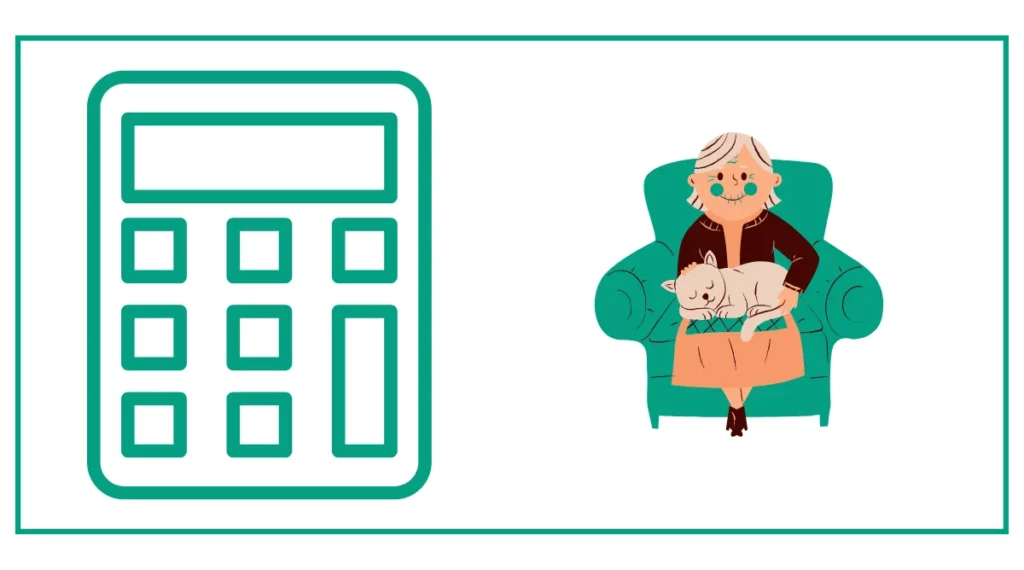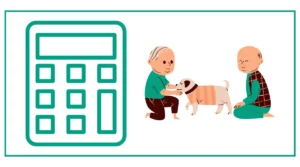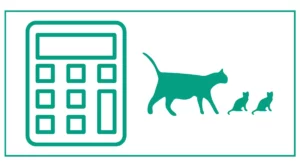Cat Age Calculator
The cat age calculator helps you calculate the age of your cat in human years and find out whether it is a teenager, adult, or senior.
Enter the age of your cat to find out the cat age in human years.
This calculator uses the following formula to figure out the cat age:
- 1 cat year =15 human years
- 2 cat years =24 human years
- Additionally each cat year = 4 human years

You might also want to determine the dog's age in human years or check if there is grape toxicity.
The Basics of Cat Age Calculation
Cats age differently than humans, and their life stages don't align perfectly with ours. While it's commonly believed that one cat year equals seven human years, the reality is more complex. Cats mature rapidly in their first two years of life, reaching the equivalent of human adolescence by their first birthday.
How Cat Years Differ from Human Years
The first year of a cat's life is equivalent to about 15 human years. By the time a cat reaches two years old, it's roughly equivalent to a 24-year-old human. After that, each additional cat year is generally equal to about four human years. This means that a 5-year-old cat is around 36 in human years.
Using Our Cat Age Calculator
To find out how old your cat is in human years, simply use our cat age calculator. Input your cat's age in years, and the calculator will provide you with the equivalent human age. This tool takes into account the rapid early development of cats and the slower aging process in later years.
How to Interpret the Results
Once you've used our cat age calculator, you'll have a better understanding of your cat's life stage. For example:
- A 1-year-old cat is equivalent to a 15-year-old human
- A 2-year-old cat is like a 24-year-old human
- A 5-year-old cat is comparable to a 36-year-old human
- A 10-year-old cat is similar to a 56-year-old human
Understanding these equivalencies can help you provide age-appropriate care and understand your cat's changing needs throughout its life.
Cat Life Stages Explained
Cats go through several distinct life stages, each with its own characteristics and care requirements. Let's explore these stages to better understand your feline companion's development.
Kitten Stage (0-6 months)
During the kitten stage, cats grow rapidly and develop crucial social skills. This period is equivalent to early childhood in humans. Kittens need frequent feeding, lots of play, and socialization to grow into well-adjusted adult cats.
Junior Stage (6 months - 2 years)
The junior stage is similar to human adolescence and young adulthood. Cats reach sexual maturity during this time and continue to grow and develop physically and mentally. They're full of energy and require plenty of stimulation and exercise.
Prime Adult Stage (3-6 years)
Cats in their prime adult years are equivalent to humans in their late 20s to early 40s. They're typically at their peak physical condition and have settled into their adult personalities. Regular veterinary check-ups and a balanced diet are essential during this stage.
Mature Adult Stage (7-10 years)
As cats enter their mature adult years, they may start to slow down a bit, similar to humans in their late 40s to early 60s. They might become less active and may require diet adjustments to maintain a healthy weight.
Senior Stage (11-14 years)
Senior cats are comparable to humans in their mid-60s to mid-70s. They may develop age-related health issues and require more frequent veterinary care. Adjustments to their environment, such as easier access to litter boxes and feeding areas, may be necessary.
Geriatric Stage (15+ years)
Cats over 15 years old are considered geriatric, equivalent to humans in their late 70s and beyond. These older cats often require specialized care and may have multiple health concerns. Regular veterinary check-ups are crucial at this stage.
Factors Affecting Cat Aging
While our cat age calculator provides a general guide, it's important to note that several factors can influence how quickly a cat ages. Understanding these factors can help you provide better care for your feline friend.
Breed Differences
Some cat breeds tend to have longer lifespans than others. For example, Siamese and Manx cats often live longer than average, while breeds like the Sphynx and Munchkin may have shorter lifespans due to genetic factors.
Indoor vs. Outdoor Lifestyle
Indoor cats typically live longer than outdoor cats. They're protected from dangers such as traffic, predators, and diseases that outdoor cats may encounter. On average, an indoor cat's lifespan can be 12-18 years, while outdoor cats often live only 2-5 years.
Diet and Nutrition
A balanced, high-quality diet appropriate for your cat's life stage can significantly impact their health and longevity. Proper nutrition supports the immune system, maintains a healthy weight, and can help prevent certain age-related issues.
Regular Veterinary Care
Routine check-ups and preventive care can help catch and address health issues early, potentially extending your cat's life. Regular dental cleanings, vaccinations, and health screenings are essential components of feline healthcare.
Genetics
Just like humans, some cats are genetically predisposed to live longer than others. Good genetics combined with proper care can lead to a longer, healthier life for your feline companion.
Signs of Aging in Cats
As your cat ages, you may notice various physical and behavioral changes. Being aware of these signs can help you adjust your care routine and seek veterinary attention when needed.
Physical Signs
- Graying fur, especially around the muzzle
- Cloudy eyes or vision changes
- Stiffness or difficulty jumping
- Weight loss or gain
- Changes in grooming habits
- Dental issues or bad breath
Behavioral Signs
- Increased sleep or changes in sleep patterns
- Reduced activity levels
- Changes in litter box habits
- Increased vocalization
- Confusion or disorientation
- Altered social interactions with humans or other pets
Caring for Cats at Different Life Stages
Understanding your cat's age in human years can help you provide appropriate care throughout its life. Here are some tips for caring for cats at different stages:
Kitten Care (0-2 years)
- Provide a high-quality kitten food
- Ensure plenty of playtime and socialization
- Begin regular veterinary check-ups and vaccinations
- Start dental care routines early
Adult Cat Care (3-10 years)
- Maintain a balanced diet appropriate for adult cats
- Provide regular exercise and mental stimulation
- Continue routine veterinary care and dental hygiene
- Monitor weight and adjust food intake as needed
Senior Cat Care (11+ years)
- Consider switching to a senior cat food formula
- Provide easier access to resources (litter boxes, food, water)
- Increase the frequency of veterinary check-ups
- Be attentive to changes in behavior or health
- Adjust the environment to accommodate reduced mobility
Common Health Issues in Aging Cats
As cats age, they become more susceptible to certain health problems. Being aware of these issues can help you spot potential problems early and seek veterinary care promptly.
Kidney Disease
Chronic kidney disease is common in older cats. Symptoms may include increased thirst and urination, weight loss, and decreased appetite.
Arthritis
Many senior cats develop arthritis, leading to reduced mobility and discomfort. Signs include difficulty jumping, stiffness, and reluctance to use stairs.
Dental Disease
Dental issues become more common as cats age. Regular dental check-ups and cleanings can help prevent or manage dental disease.
Hyperthyroidism
This condition, caused by an overactive thyroid gland, is common in older cats. Symptoms include weight loss despite increased appetite, increased thirst, and restlessness.
Cancer
Various forms of cancer can affect aging cats. Regular check-ups can help detect cancer early when it's most treatable.
Extending Your Cat's Lifespan
While you can't stop the aging process, there are steps you can take to help your cat live a longer, healthier life:
- Provide a high-quality, balanced diet appropriate for your cat's life stage
- Ensure regular veterinary care, including annual check-ups and vaccinations
- Keep your cat at a healthy weight through proper diet and exercise
- Maintain good dental hygiene with regular brushing and professional cleanings
- Provide mental stimulation through play and environmental enrichment
- Keep your cat indoors to protect them from outdoor hazards
- Address health issues promptly when they arise
- Provide a stress-free environment with plenty of love and attention
Conclusion
Our cat age calculator is a valuable tool for understanding your feline friend's stage of life. By knowing your cat's age in human years, you can better anticipate their needs, provide appropriate care, and potentially identify health issues early. Remember, every cat is unique, and while these guidelines are helpful, your veterinarian is the best resource for specific advice about your cat's health and care needs.
Whether you have a playful kitten, a mature adult cat, or a senior feline companion, understanding their age in human years can help you forge a deeper bond and provide the best possible care throughout their life. Use our cat age calculator regularly to stay informed about your cat's changing needs as they progress through different life stages.

References
- How Do Cat Years Work: How Old is My Cat? (n.d.). Natusan. natusan.co.uk/blogs/inside-scoop/how-do-cat-years-work-how-old-is-my-cat
- Metz, J. (2015). Cat Age. Mathematics Teaching in the Middle School, 21(2), 128-128.





